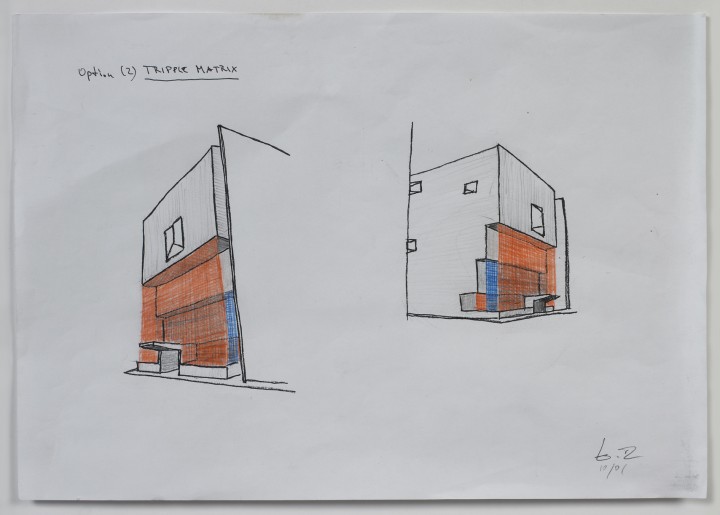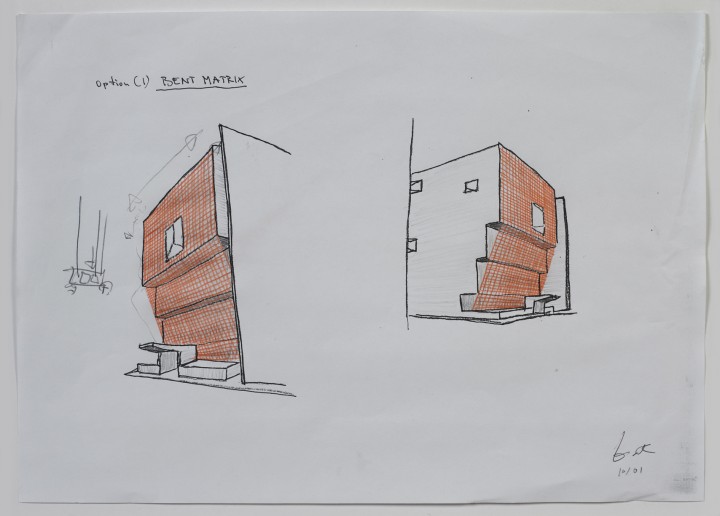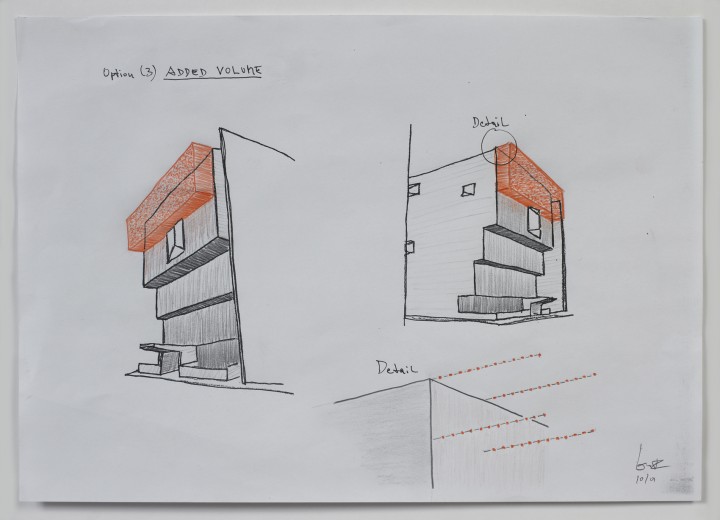
Figure 1. Erwin Redl, Whitney Biennial 2002 Proposal (Option 2), 2001
Graphite, colored pencil, and marker over photocopy on paper, 11 5/8 x 8 1/4 inches (29.5 x 21 cm)
© 2012 Erwin Redl
Erwin Redl
In Conversation with Rachel Nackman
New York, June 2012
Rachel Nackman: How does drawing figure in the entirety of your work?
Erwin Redl: There are two ways that drawing fits into my work. First, it can function purely as an engineering tool; second, it serves as an artistic expression. Then there’s everything in between.
RN: This series of drawings was made in 2001 as part of your proposal to the Whitney Museum for its 2002 Biennial. The project ultimately realized was a light installation on the façade of the Marcel Breuer building.
ER: Engineering is a very creative trade. These drawings were made on paper, but now much of the engineering work is done on the computer. Very often we don’t even print it out anymore. Going back to 2001, everything was done by hand. My technician and I would sit with two pencils and draw on the same drawing. The artistic part was solely in my corner, but when it comes to figuring out how you should work in the real world, with real problems, the plans are made collaboratively.
In 2001 the visualization process was almost exclusively completed by hand. Even though much of the work is done on computers today, I continue to sketch ideas for myself by hand because I love the gestures. It’s good to have a corporeal step between the idea and its realization in the three-dimensional world, and that step is made by hand.
There’s a whole group of artists and engineers that I call “pixel pushers.” They don’t have any idea about gravity or mass or volume, because for them those concepts are just pixels on their screen. I grew up in a workshop with my father, who was a furniture maker. For me, everything was about mass. As a kid I grabbed stuff intuitively and learned by osmosis—not in an abstract way, like with a pixel. It’s very different now. I’m not saying it’s better or worse. It’s just a different concept of reality.
RN: Can you tell by looking at these drawings at what point in the development of the piece they were made? Were there other drawings made before these?

Figure 2. Erwin Redl, Whitney Biennial 2002 Proposal (Option 1), 2001
Graphite, colored pencil, and marker over photocopy on paper, 11 5/8 x 8 1/4 inches (29.5 x 21 cm)
© 2012 Erwin Redl
ER: These drawings showed different versions of what I could do. Larry Rinder, the curator at the Whitney, saw my piece MATRIX IV in the Brooklyn Bridge Anchorage as part of Creative Time’s project Massless Medium: Explorations in Sensory Immersion in 2001. He asked me to do something for the Biennial.
In preparing for this piece, I had to tell them what I wanted to do and think carefully about how it could be done, because we were dealing with the Marcel Breuer building. It’s a landmark; you can’t drill into the façade. It was a long process—between an idea, the rehearsal of the idea, and then what you actually do.
Most of the time the idea process is very quick. I don’t fuss around too much, especially at the scale of these drawings. The ideas are mostly spontaneous. If I go to look at the space while working on a proposal, it usually just happens. How it happens goes with the experience—seeing how it influences you.
Then you have to present the idea to yourself, because at first it’s just in your headspace. Get it out and look at it. How does this actually look? Not just in your head but on real material, in a drawing.
RN: Is that process like a translation?
ER: It’s just like a translation. You have an idea about something you want to do, and then you have to explain it to somebody else. The older you get, the more experienced you get in translating whatever drives you, in presenting your ideas to the rest of the universe.
A drawing for this type of work is the translation of an idea that becomes something else later on. I make other works that are a whole different type of drawing. They are out there on their own terms, and they make no reference to anything else. But of course they’re made by the same person, and they employ similar principles.
RN: Once these drawings were presented to Larry Rinder and you had made a collaborative decision about what would be installed, what happened to the drawings? Were they used in the installation?
ER: Not really. The engineer needs to get an idea of what the piece should look like, so that he or she can visualize the end result in terms of the engineering. We try to further translate the idea so that it can actually be realized.
RN: So from these preliminary conceptual drawings, you had to move into a completely separate set of drawings.
ER: Yes, and at that point it was all done by hand. We managed to do it, and nothing fell on anybody’s head, which is good.
With this work, I wasn’t trying to modify architecture. The Breuer building is there, and I put something else there that is on equal terms. The architecture creates a spatial event or tension. My piece is not there to counter it; it’s just there to grab what’s underneath and present it, like an invisible force in space. I’m plumbing space; that’s my job. The space already has the tension. I find those invisible points of tension and squeeze them a little bit, and then the space becomes physically different.
RN: Today, in 2012, do you still make drawings like this as part of your working process?
ER: Yes, I still make drawings like this, but the process has changed a lot. You don’t give a drawing to someone as a proposal anymore; you send a PowerPoint or you send a PDF. But even so, I scan drawings.
RN: Drawing still has to be the way you get to the next steps?

Erwin Redl, Whitney Biennial 2002 Proposal (Option 3), 2001
Graphite, colored pencil, and marker over photocopy on paper, 11 5/8 x 8 1/4 inches (29.5 x 21 cm)
© 2012 Erwin Redl
ER: Among other things. I like drawing by hand, because then I feel more connected to the project than I do making a 3-D model on the computer. But some people can’t even express themselves that well on paper anymore. Today you can download a software program, and suddenly you have your idea in 3-D. Everything is done very quickly.
RN: After realizing this installation at the Whitney Biennial, how do you feel about these drawings being shown as artworks in an exhibition?
ER: They will always be shown in the context of the installation, because they’re representational, and I don’t make representational art. These drawings represent the piece I made at the Whitney. Viewers will know that these drawings were not meant to stand on their own feet, like an abstract drawing is meant to do.
RN: Can you tell us about the drawings that you make as finished works, which have no relation to your light installations?
ER: Well, those drawings are purely flat, and most of them are monochromatic. They’re based on very simple grid systems, but within each system there are small individual gestures. I use that type of drawing to embrace Minimalism. That’s what it is, and that’s why I’m interested in it.
RN: Do you ever think about your abstract drawings while you’re making light installations?
ER: Oh, yes. They come out of the same mold, and they influence each other radically. I sketch something by hand, and I might take that idea and turn it into an independent drawing, or it might work for an installation—or both, or neither. I trust my intuition.
RN: Notations includes drawings by Fred Sandback and Dan Flavin, both of whom made finished drawings and proposals for installations. Do you have a relationship with either artist’s work?
ER: Fred Sandback changed my life—that’s my relationship to Mr. Sandback. Before I saw his work in person, I had seen it in some exhibition catalogs. In 1997, when I was in the residency program at PS1, I was focused on computer installations that were either projected or on a screen. At the Dia Center in Chelsea there was a Fred Sandback exhibition, and when I saw it, I was completely knocked dead. The next day I went back to my studio, I packed away my computers, and I made my first light installation. It was a 360-degree difference.
For me, what Sandback did was exactly what I had always wanted to do. I was interested in abstraction—but corporeal abstraction, in a purely spatial way. It doesn’t get much more minimal than Sandback. It’s a very geometric, clear, delineated feeling that his work provides, and that was a complete knockout for me. I was blown away.
Dan Flavin was influential in a different way. Of course he also used lights; that’s by default very close to what I do. But the early Flavin was a sculptor. He used fluorescence like a sculptor would, making works with three-dimensional mass. Those works also involve time. How much time do you spend in the space so that your eye adjusts to the light? How much time does it take to traverse the space so that your perception changes?
RN: Your first and most affecting experiences with both Sandback and Flavin were with their sculpture.
ER: Yes, absolutely.
RN: How do you feel about their drawing practices?
ER: I can’t separate their drawing from their sculpture. You see it, and you cannot erase your memory—it is all related to that formative experience. When you experience that work, it is with the whole body. I get the same goose bumps—the same corporeal goose bumps—seeing their drawings. I don’t make a distinction.
In talking about drawings, Sol LeWitt is another very big influence. His wall drawings have had an enormous influence on my work. Those drawings give me the same goose bumps. LeWitt’s space is completely structured—tightly and very narrowly structured—but infinite at the same time. I don’t think it’s a retinal experience so much as a whole-body experience.
RN: It doesn’t matter what the medium is?
ER: It really doesn’t matter.
RN: In your work, however, there’s a difference between looking at your drawings and looking at a light installation. So the medium creates certain specificities?
ER: Oh yes. For me, it’s completely different. I try to be accomplished in the medium itself. If I want to draw, I want to take the time to become a good draftsman. And it’s the same with light installations: you have to know a lot of engineering to express your ideas.
That’s it; the rest is just about the idea, which is abstract. In my case the idea is abstract in that it’s not representational—but not abstract in that it’s not corporeal. It’s always corporeal for me.
Bios
Rachel Nackman
Erwin Redl
